Energy Generation and Attenuation of Blast-Induced Seismic Waves under In Situ Stress Conditions
Abstract
:1. Introduction
2. Theoretical Analysis of Blasting Seismic Energy Generation and Attenuation under In Situ Stress
2.1. Seismic Energy Generated in Rock Blasting under In Situ Stress
2.2. Seismic Energy Attenuation
3. Numerical Study of Blasting Seismic Energy Generation and Attenuation under In Situ Stress
3.1. Conceptual Model of Multiple-Hole Blasting under In Situ Stress
3.2. Numerical Model and Simulation Method
3.2.1. Coupled SPH-FEM Modeling Method
3.2.2. Rock and Explosive Models
3.2.3. Validation of Material Models and Parameters
3.2.4. Numerical Model and Boundary Conditions
3.3. Seismic Energy Generation and Attenuation under Hydrostatic In Situ Stress
3.3.1. Seismic Energy on the Elastic Boundary
3.3.2. Seismic Energy Attenuation with Distance
3.4. Seismic Energy Generation and Attenuation under Non-Hydrostatic In Situ Stress
3.4.1. Seismic Energy Density on the Elastic Boundary
3.4.2. Seismic Energy Density Attenuation with Distance
4. A Case Study
4.1. Site Description
4.2. Blasting Design and Vibration Monitoring
4.3. Seismic Energy Attenuation Analysis and Discussion
5. Conclusions
- (1)
- In situ stress has an important effect on the initial seismic energy generated in deep rock blasting. With the increase in the in situ stress level, the explosive energy consumed in the rock fracture is reduced, and more explosive energy is converted into seismic energy.
- (2)
- The blasting seismic energy attenuation, specifically its viscoelastic attenuation, is affected by the in situ stress level. The increasing in situ stress causes the seismic Q to first increase and then decrease, and thereby the attenuation rate of the seismic energy first decreases and then increases. The blasting seismic energy attenuation under in situ stress conditions is slower than that of the case without in situ stress. Compared to shallow rock blasting, the seismic waves generated in deep rock blasting are more likely to reach and exceed the PPV limits specified in the blasting vibration standards.
- (3)
- Under non-hydrostatic in situ stress, the blasting seismic energy generation and attenuation are anisotropic. The anisotropy becomes more significant with an increase in the lateral coefficient that is greater than 1.0. The seismic energy density generated in the minimum principal stress orientation is the highest. The attenuation rate of the seismic energy density is mainly affected by the stress that aligns with the wave propagation orientation.
Author Contributions
Funding
Institutional Review Board Statement
Informed Consent Statement
Data Availability Statement
Acknowledgments
Conflicts of Interest
References
- Scheepers, L.; Malan, D.F. A Case Study of Geotechnical Conditions Affecting Mining-Induced Seismicity in a Deep Tabular Mine. J. S. Afr. Inst. Min. Metall. 2022, 122, 115–124. [Google Scholar] [CrossRef]
- Yabe, Y.; Abe, S.; Ito, T.; Ishida, A.; Sugimura, K.; Kanematsu, M.; Higashi, M.; Tadokoro, R.; Ogasawara, H.; Funato, A.; et al. In-Situ Stress around Source Faults of Seismic Events in and beneath South African Deep Gold Mines. In Proceedings of the Deep Mining 2019: Proceedings of the Ninth International Conference on Deep and High Stress Mining, Johannesburg, South Africa, 24–25 June 2019; pp. 399–411. [Google Scholar]
- He, S.; Lai, J.; Zhong, Y.; Wang, K.; Xu, W.; Wang, L.; Liu, T.; Zhang, C. Damage Behaviors, Prediction Methods and Prevention Methods of Rockburst in 13 Deep Traffic Tunnels in China. Eng. Fail. Anal. 2021, 121, 105178. [Google Scholar] [CrossRef]
- Zhang, Z.X.; Ouchterlony, F. Energy Requirement for Rock Breakage in Laboratory Experiments and Engineering Operations: A Review. Rock Mech. Rock Eng. 2022, 55, 629–667. [Google Scholar] [CrossRef]
- Ainalis, D.; Kaufmann, O.; Tshibangu, J.P.; Verlinden, O.; Kouroussis, G. Modelling the Source of Blasting for the Numerical Simulation of Blast-Induced Ground Vibrations: A Review. Rock Mech. Rock Eng. 2017, 50, 171–193. [Google Scholar] [CrossRef]
- Gutowski, T.G.; Dym, C.L. Propagation of Ground Vibration: A Review. J. Sound Vib. 1976, 49, 179–193. [Google Scholar] [CrossRef]
- Blair, D.P. Blast Vibration Dependence on Charge Length, Velocity of Detonation and Layered Media. Int. J. Rock Mech. Min. Sci. 2014, 65, 29–39. [Google Scholar] [CrossRef]
- Blair, D.P. The Free Surface Influence on Blast Vibration. Int. J. Rock Mech. Min. Sci. 2015, 77, 182–191. [Google Scholar] [CrossRef]
- Gu, W.; Wang, Z.; Chen, J.; Liu, J.; Lu, M. Experimental and Theoretical Study on Influence of Different Charging Structures on Blasting Vibration Energy. Shock Vib. 2015, 2015, 248739. [Google Scholar] [CrossRef]
- Roy, M.P.; Mishra, A.K.; Agrawal, H.; Singh, P.K. Blast Vibration Dependence on Total Explosives Weight in Open-Pit Blasting. Arab. J. Geosci. 2020, 13, 531. [Google Scholar] [CrossRef]
- Mpofu, M.; Ngobese, S.; Maphalala, B.; Roberts, D.; Khan, S. The Influence of Stemming Practice on Ground Vibration and Air Blast. J. S. Afr. Inst. Min. Metall. 2021, 121, 1–10. [Google Scholar] [CrossRef]
- Gui, Y.L.; Zhao, Z.Y.; Jayasinghe, L.B.; Zhou, H.Y.; Goh, A.T.C.; Tao, M. Blast Wave Induced Spatial Variation of Ground Vibration Considering Field Geological Conditions. Int. J. Rock Mech. Min. Sci. 2018, 101, 63–68. [Google Scholar] [CrossRef]
- Yu, C.; Yue, H.; Li, H.; Xia, X.; Liu, B. Scale Model Test Study of Influence of Joints on Blasting Vibration Attenuation. Bull. Eng. Geol. Environ. 2021, 80, 533–550. [Google Scholar] [CrossRef]
- Gonen, A. Investigation of Fault Effect on Blast-Induced Vibration. Appl. Sci. 2022, 12, 2278. [Google Scholar] [CrossRef]
- Yilmaz, O. The Comparison of Most Widely Used Ground Vibration Predictor Equations and Suggestions for the New Attenuation Formulas. Environ. Earth Sci. 2016, 75, 269. [Google Scholar] [CrossRef]
- Sun, P.; Lu, W.; Zhou, J.; Huang, X.; Chen, M.; Li, Q. Comparison of Dominant Frequency Attenuation of Blasting Vibration for Different Charge Structures. J. Rock Mech. Geotech. Eng. 2022, 14, 448–459. [Google Scholar] [CrossRef]
- Jung, D.; Choi, Y. Prediction of Blast Vibration in Quarry Using Machine Learning Models. Tunn. Undergr. Space 2021, 31, 508–519. [Google Scholar]
- Zaid, M.; Sadique, M.R. Numerical Modelling of Internal Blast Loading on a Rock Tunnel. Adv. Comput. Des. 2020, 5, 417–443. [Google Scholar]
- Zaid, M.; Sadique, M.R. A Simple Approximate Simulation Using Coupled Eulerian-Lagrangian (CEL) Simulation in Investigating Effects of Internal Blast in Rock Tunnel. Ind. Geotech. J. 2021, 51, 1038–1055. [Google Scholar] [CrossRef]
- Zaid, M.; Shah, I.A. Numerical Analysis of Himalayan Rock Tunnels under Static and Blast Loading. Geotech. Geol. Eng. 2021, 39, 5063–5083. [Google Scholar] [CrossRef]
- Zaid, M.; Sadique, M.R. The Response of Rock Tunnel When Subjected to Blast Loading: Finite Element Analysis. Eng. Rep. 2021, 3, e12293. [Google Scholar] [CrossRef]
- Zaid, M.; Sadique, M.; Alam, M. Blast Analysis of Tunnels in Manhattan-Schist and Quartz-Schist Using Coupled-Eulerian–Lagrangian Method. Innov. Infrastruct. Solut. 2021, 6, 69. [Google Scholar] [CrossRef]
- Zaid, M.; Sadique, M.R.; Samanta, M. Effect of Unconfined Compressive Strength of Rock on Dynamic Response of Shallow Unlined Tunnel. SN Appl. Sci. 2020, 2, 2131. [Google Scholar] [CrossRef]
- Zaid, M.; Sadique, M.R.; Alam, M.M.; Samanta, M. Effect of Shear Zone on Dynamic Behaviour of Rock Tunnel Constructed in Highly Weathered Granite. Geomech. Eng. 2020, 23, 245–259. [Google Scholar]
- Yang, J.; Wu, Z.; Sun, W.; Yao, C.; Wang, Q. Numerical Simulation on Radiation and Energy of Blast-Induced Seismic Waves in Deep Rock Masses. J. Cent. South Univ. 2022, 29, 645–662. [Google Scholar] [CrossRef]
- Fan, L.F.; Sun, H.Y. Seismic Wave Propagation through an In-Situ Stressed Rock Mass. J. Appl. Geophys. 2015, 121, 13–20. [Google Scholar] [CrossRef]
- Liu, T.; Li, X.; Zheng, Y.; Meng, F.; Song, D. Analysis of Seismic Waves Propagating through an In Situ Stressed Rock Mass Using a Nonlinear Model. Int. J. Geomech. 2020, 20, 04020002. [Google Scholar] [CrossRef]
- Li, Z.; Li, J.; Li, H.; Zhao, J. Effects of a Set of Parallel Joints with Unequal Close-Open Behavior on Stress Wave Energy Attenuation. Wave Random Complex 2021, 31, 2427–2451. [Google Scholar] [CrossRef]
- Dong, Q.; Li, X.; Jia, Y.; Sun, J. A Numerical Simulation of Blasting Stress Wave Propagation in a Jointed Rock Mass under Initial Stresses. Appl. Sci. 2021, 11, 7873. [Google Scholar] [CrossRef]
- Zhu, J.; Li, Y.; Peng, Q.; Deng, X.; Gao, M.; Zhang, J. Stress Wave Propagation across Jointed Rock Mass under Dynamic Extension and Its Effect on Dynamic Response and Supporting of Underground Opening. Tunn. Undergr. Sp. Technol. 2021, 108, 103648. [Google Scholar] [CrossRef]
- Dong, Q.; Li, X.; Huang, J. Model Test Study on Cylindrical Blasting Stress Wave Propagation across Jointed Rock Mass with Different Initial Stresses. Adv. Civil Eng. 2020, 2020, 8881302. [Google Scholar] [CrossRef]
- Zhang, F.; Yan, G.; Yang, Q.; Gao, J.; Li, Y. Strain Field Evolution Characteristics of Free Surface during Crater Blasting in Sandstone under High Stress. Appl. Sci. 2020, 10, 6285. [Google Scholar] [CrossRef]
- Sanchidrián, J.A.; Segarra, P.; López, L.M. Energy Components in Rock Blasting. Int. J. Rock Mech. Min. Sci. 2007, 44, 130–147. [Google Scholar] [CrossRef]
- Zhu, Z.; Mohanty, B.; Xie, H. Numerical Investigation of Blasting-Induced Crack Initiation and Propagation in Rocks. Int. J. Rock Mech. Min. Sci. 2007, 44, 412–424. [Google Scholar] [CrossRef]
- Hinzen, K.G. Comparison of Seismic and Explosive Energy in Five Smooth Blasting Test Rounds. Int. J. Rock Mech. Min. Sci. 1998, 35, 957–967. [Google Scholar] [CrossRef]
- Jiang, G.; Zuo, J.; Li, Y.; Wei, X. Experimental Investigation on Mechanical and Acoustic Parameters of Different Depth Shale Under The Effect of Confining Pressure. Rock Mech. Rock Eng. 2019, 52, 4273–4286. [Google Scholar] [CrossRef]
- Wang, Y.; Liu, D.Q.; Zhao, Z.H.; Wang, H.J. Investigation on the Effect of Confining Pressure on the Geomechanical and Ultrasonic Properties of Black Shale Using Ultrasonic Transmission and Post-Test CT Visualization. J. Petrol. Sci. Eng. 2020, 185, 106630. [Google Scholar] [CrossRef]
- Asef, M.R.; Najibi, A.R. The Effect of Confining Pressure on Elastic Wave Velocities and Dynamic to Static Young’s Modulus Ratio. Geophysics 2013, 78, D135–D142. [Google Scholar] [CrossRef]
- Córdova, E.; Gottreux, I.; Anani, A.; Ferrada, A.; Contreras, J.S. Blasting and Preconditioning Modelling in Underground Cave Mines under High Stress Conditions. J. S. Afr. Inst. Min. Metall. 2021, 121, 71–80. [Google Scholar] [CrossRef]
- Li, X.; Zhu, Z.; Wang, M.; Wan, D.; Zhou, L.; Liu, R. Numerical Study on the Behavior of Blasting in Deep Rock Masses. Tunn. Undergr. Sp. Technol. 2021, 113, 103968. [Google Scholar] [CrossRef]
- Yan, G.; Yang, Q.; Zhang, F.; Hao, Q.; Wang, X.; Wang, H. Experimental Study on the Effects of In Situ Stress on the Initiation and Propagation of Cracks during Hard Rock Blasting. Appl. Sci. 2021, 11, 11169. [Google Scholar] [CrossRef]
- Ding, C.; Yang, R.; Yang, L. Experimental Results of Blast-Induced Cracking Fractal Characteristics and Propagation Behavior in Deep Rock Mass. Int. J. Rock Mech. Min. Sci. 2021, 142, 104772. [Google Scholar] [CrossRef]
- Picotti, S.; Carcione, J.M.; Ba, J. Rock-Physics Templates Based on Seismic Q. Geophysics 2019, 84, MR13–MR23. [Google Scholar] [CrossRef]
- Johnston, D.H.; Toksöz, M.N. Ultrasonic P and S Wave Attenuation in Dry and Saturated Rocks under Pressure. J. Geophys. Res. 1980, 85, 925–936. [Google Scholar] [CrossRef]
- Somogyiné Molnár, J.; Kiss, A.; Dobróka, M. Petrophysical Models to Describe the Pressure Dependence of Acoustic Wave Propagation Characteristics. Acta. Geod. Geophys. 2015, 50, 339–352. [Google Scholar] [CrossRef]
- Fakhimi, A.; Lanari, M. DEM–SPH Simulation of Rock Blasting. Comput. Geotech. 2014, 55, 158–164. [Google Scholar] [CrossRef]
- Koneshwaran, S.; Thambiratnam, D.P.; Gallage, C. Blast Response of Segmented Bored Tunnel Using Coupled SPH–FE Method. Structures 2015, 2, 58–71. [Google Scholar] [CrossRef]
- Lu, Y.; Wang, Z.; Chong, K. A Comparative Study of Buried Structure in Soil Subjected to Blast Load Using 2D and 3D Numerical Simulations. Soil Dyn. Earthq. Eng. 2005, 25, 275–288. [Google Scholar] [CrossRef]
- Riedel, W.; Thoma, K.; Hiermaier, S.; Schmolinske, E. Penetration of Reinforced Concrete by BETA-B-500 Numerical Analysis Using a New Macroscopic Concrete Model for Hydrocodes. In Proceedings of the 9th International Symposium on the Effects of Munitions with Structures, Berlin, Germany, 3–7 May 1999; pp. 211–221. [Google Scholar]
- Borrvall, T.; Riedel, W. The RHT Concrete Model in LS-DYNA. In Proceedings of the 8th European LS-DYNA User Conference, Strasbourg, France, 23–24 May 2011. [Google Scholar]
- Li, H. The Study of the Rock RHT Model and to Determine the Values of Main Parameters. Ph.D. Thesis, China University of Mining & Technology-Beijing, Beijing, China, 2016. [Google Scholar]
- Sanchidrian, J.A.; Castedo, R.; Lopez, L.M.; Segarra, P.; Santos, A.P. Determination of the JWL Constants for ANFO and Emulsion Explosives from Cylinder Test Data. Cent. Eur. J. Energ. Mat. 2015, 12, 177–194. [Google Scholar]
- Castedo, R.; Natale, M.; López, L.M.; Sanchidrián, J.A.; Santos, A.P.; Navarro, J.; Segarra, P. Estimation of Jones-Wilkins-Lee Parameters of Emulsion Explosives Using Cylinder Tests and Their Numerical Validation. Int. J. Rock Mech. Min. Sci. 2018, 112, 290–301. [Google Scholar] [CrossRef]
- Jung, W.J.; Utagawa, M.; Ogata, Y.; Seto, M.; Katsuyama, K.; Miyake, A.; Ogawa, T. Effects of Rock Pressure on Crack Generation during Tunnel Blasting. J. Japan Explos. Soc. 2001, 62, 138–146. [Google Scholar]
- Ben-Menahem, A.; Singh, S.J. Seismic Waves and Sources; Springer Science & Business Media: New York, NY, USA, 2012. [Google Scholar]
- Yang, J.; Lu, W.; Li, P.; Yan, P. Evaluation of Rock Vibration Generated in Blasting Excavation of Deep-Buried Tunnels. KSCE J. Civ. Eng. 2018, 22, 2593–2608. [Google Scholar] [CrossRef]

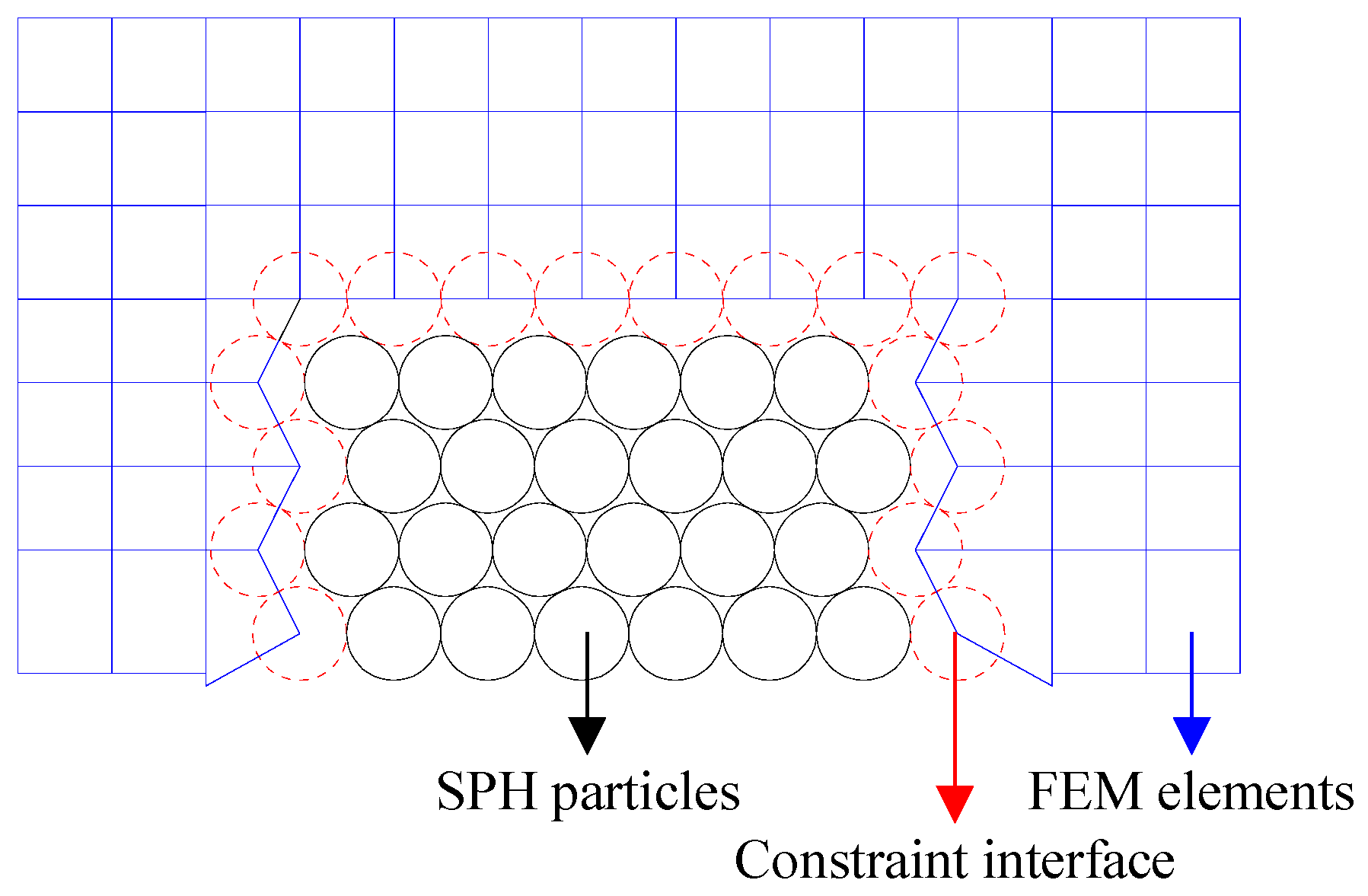

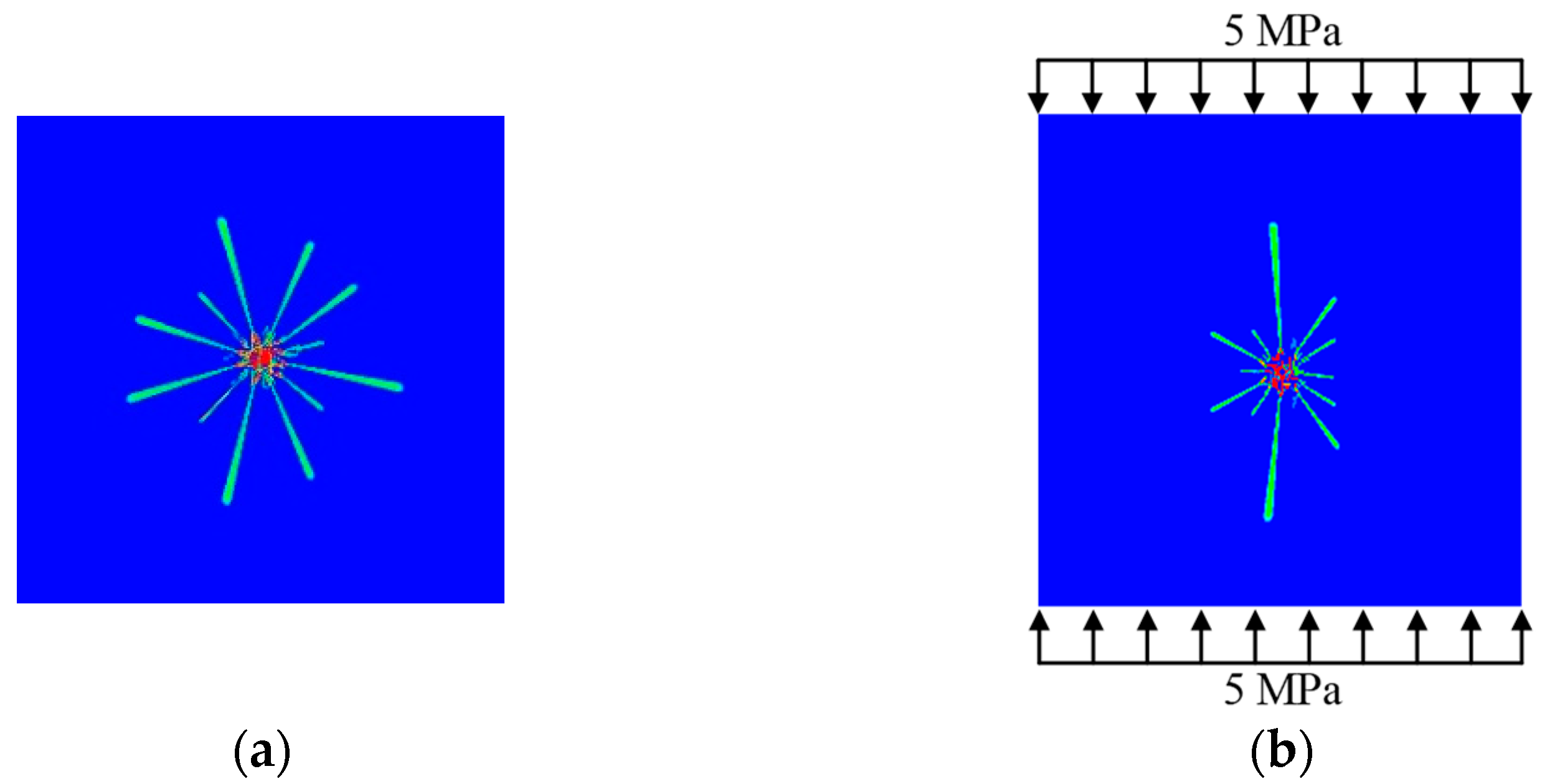
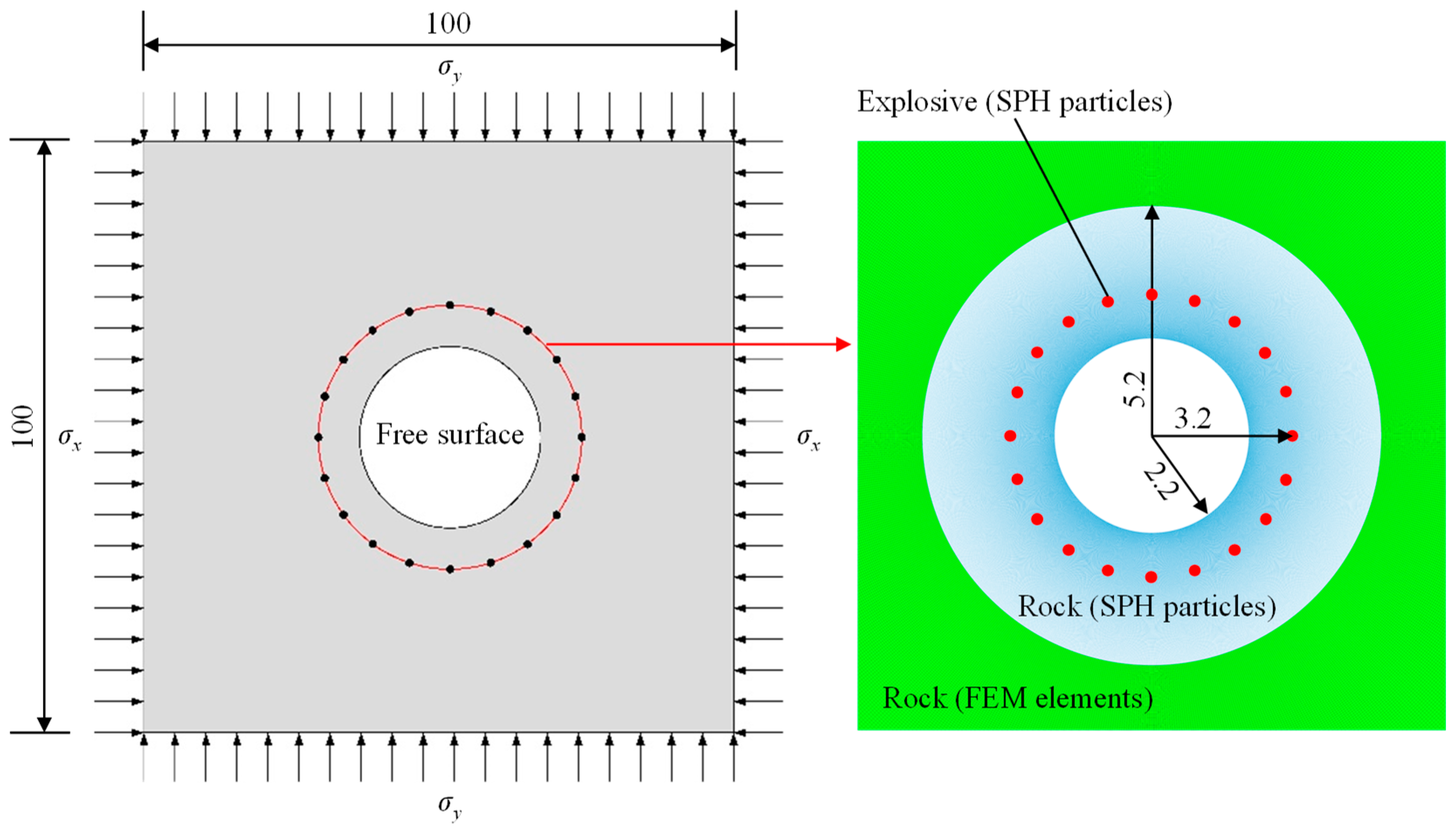

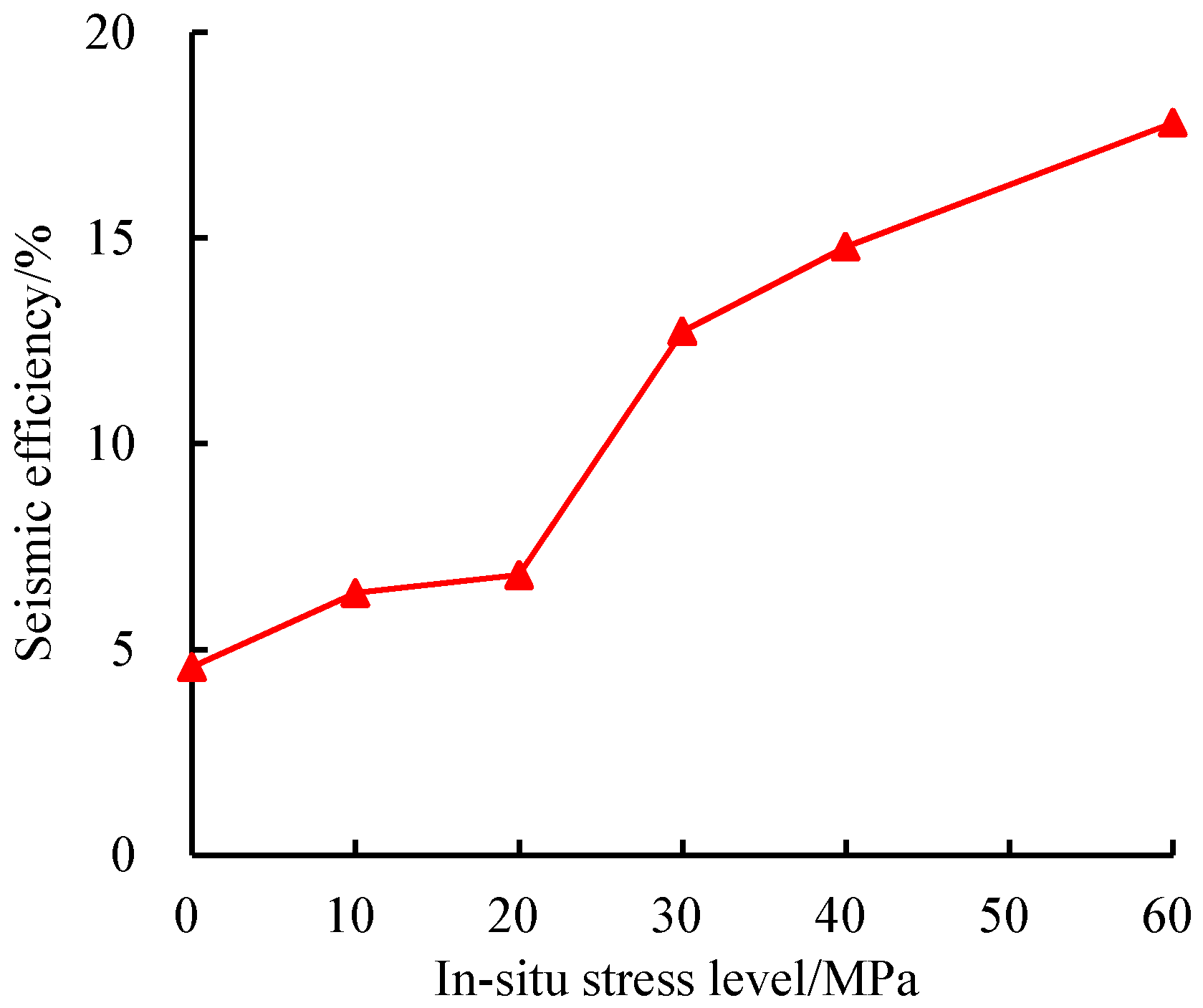
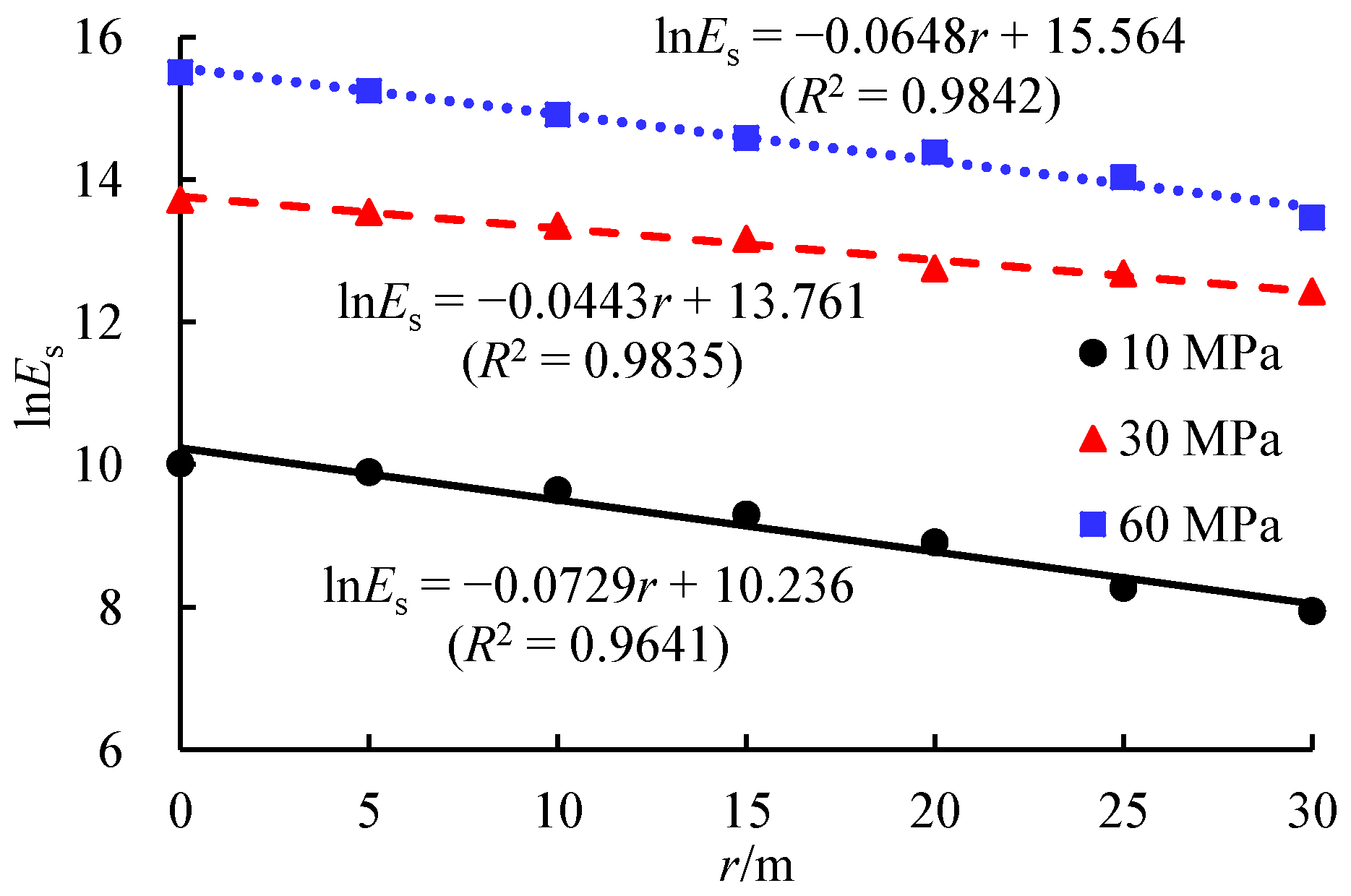

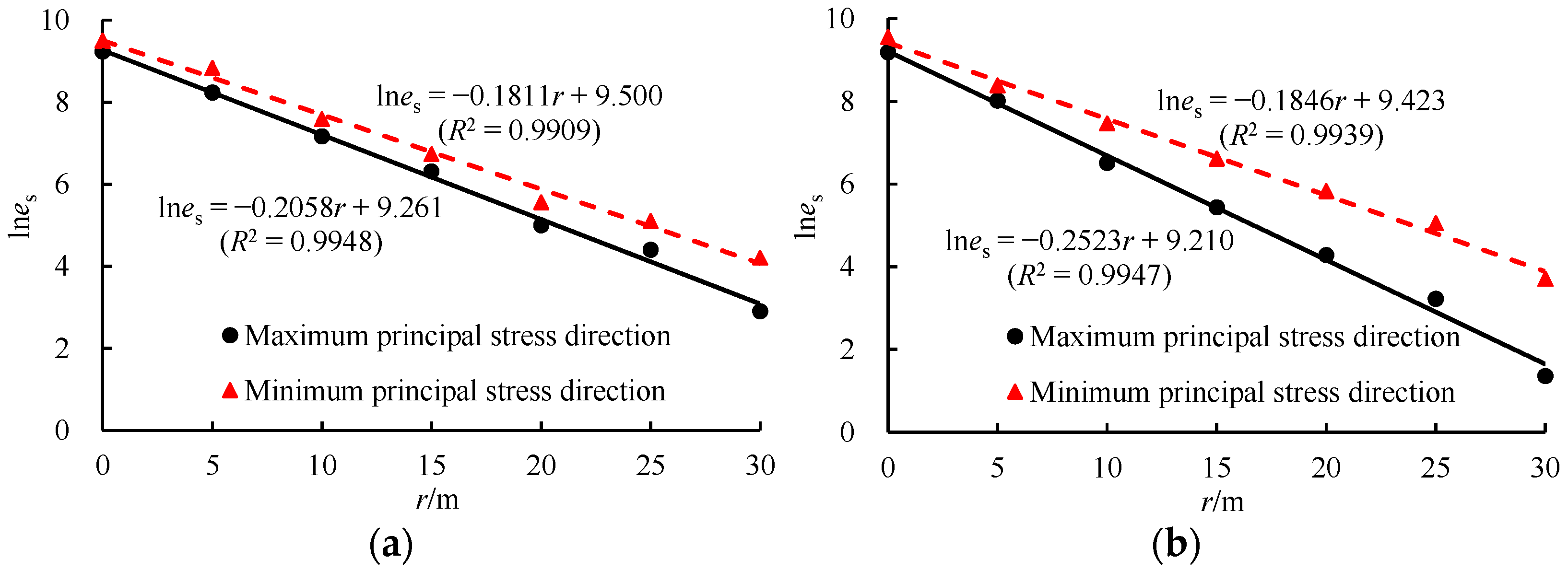
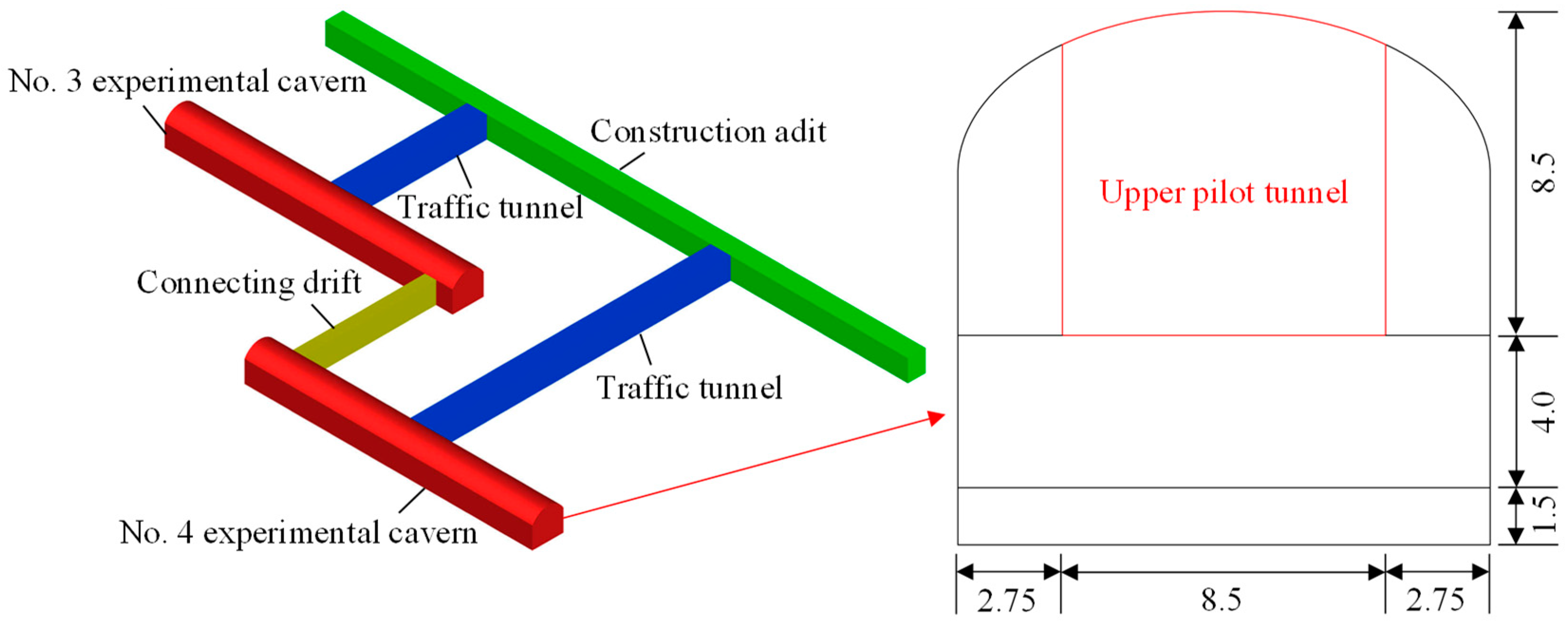
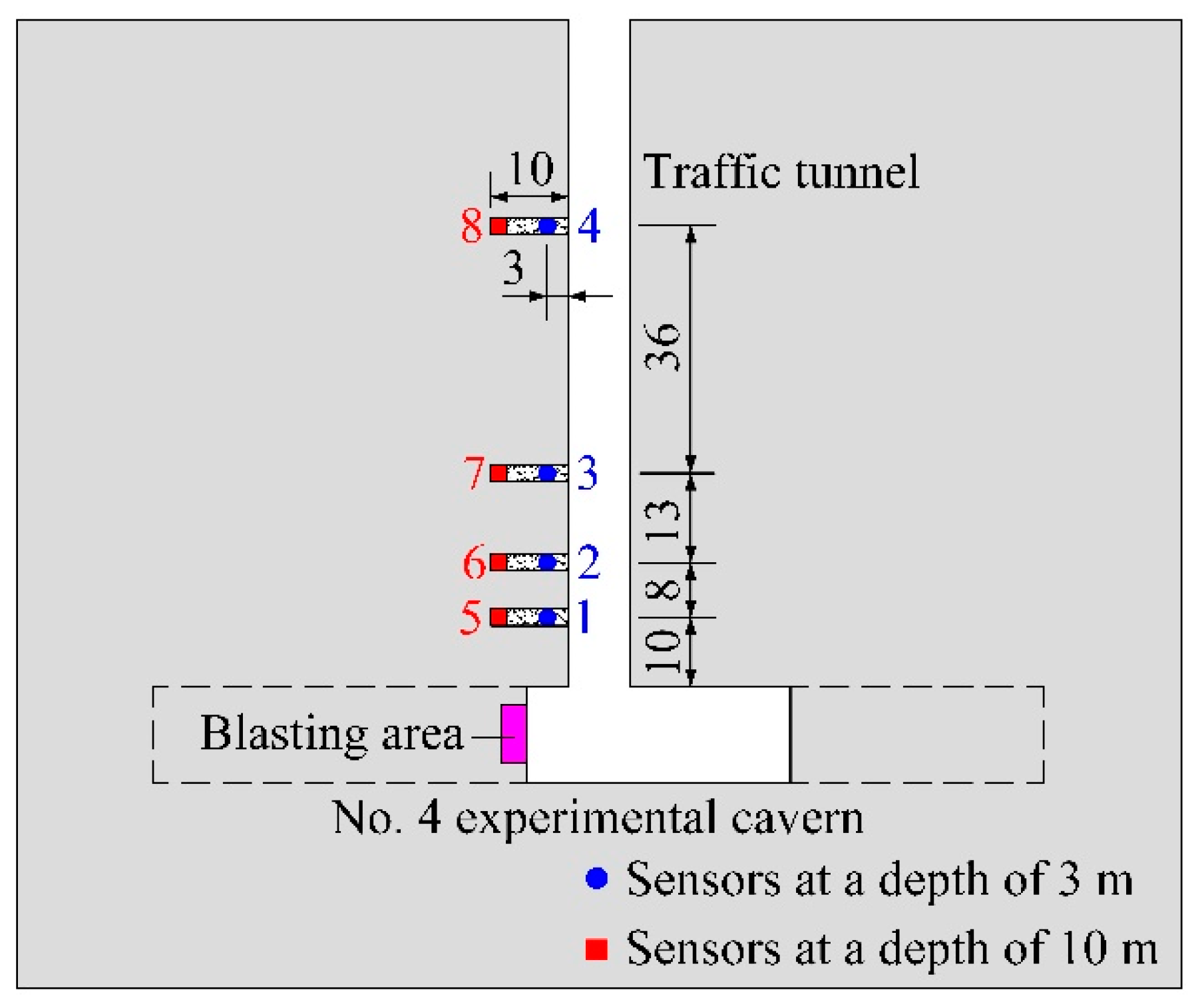

| Type | Parameter | Value | Parameter | Value |
|---|---|---|---|---|
| Basic parameters | Mass density (kg/m3) | 2700 | Relative tensile strength | 0.10 |
| Shear modulus (GPa) | 8.0 | Relative shear strength | 0.25 | |
| Compressive strength (MPa) | 48.0 | |||
| Strength parameters | Failure surface parameter A | 1.65 | Tensile yield surface parameter | 0.70 |
| Failure surface parameter N | 0.56 | Shear modulus reduction factor | 0.44 | |
| Lode angle dependence factor Q0 | 0.70 | Minimum damaged residual strain | 0.01 | |
| Lode angle dependence factor BQ | 0.0105 | Residual surface parameter B | 1.59 | |
| Compressive yield surface parameter | 0.78 | Residual surface parameter M | 0.62 | |
| Damage parameters | Damage parameter D1 | 0.0037 | Damage parameter D2 | 1 |
| Strain rate parameters | Reference compressive strain rate (s−1) | 3.0 × 10−5 | Break tensile strain rate (s−1) | 3.0 × 1025 |
| Reference tensile strain rate (s−1) | 3.0 × 10−6 | Compressive strain rate dependence exponent | 0.024 | |
| Break compressive strain rate (s−1) | 3.0 × 1025 | Tensile strain rate dependence exponent | 0.029 | |
| EOS parameters | Initial porosity | 1.078 | Hugoniot polynomial coefficient A2 (GPa) | 40.851 |
| Porosity exponent | 4.000 | Hugoniot polynomial coefficient A3 (GPa) | 4.198 | |
| Crush pressure (GPa) | 0.016 | Parameter for polynomial EOS B0 | 0.900 | |
| Compaction pressure (GPa) | 0.800 | Parameter for polynomial EOS B1 | 0.900 | |
| Gruneisen gamma | 0 | Parameter for polynomial EOS T1 (GPa) | 45.390 | |
| Hugoniot polynomial coefficient A1 (GPa) | 45.390 | Parameter for polynomial EOS T2 (GPa) | 0 |
| In Situ Stress Levels (Mpa) | Energy Attenuation Index | Seismic Q |
|---|---|---|
| 0 | 0.0940 | 82 |
| 10 | 0.0729 | 102 |
| 20 | 0.0597 | 116 |
| 30 | 0.0443 | 120 |
| 40 | 0.0578 | 98 |
| 60 | 0.0648 | 90 |
Publisher’s Note: MDPI stays neutral with regard to jurisdictional claims in published maps and institutional affiliations. |
© 2022 by the authors. Licensee MDPI, Basel, Switzerland. This article is an open access article distributed under the terms and conditions of the Creative Commons Attribution (CC BY) license (https://creativecommons.org/licenses/by/4.0/).
Share and Cite
Yang, J.; Sun, J.; Jia, Y.; Yao, Y. Energy Generation and Attenuation of Blast-Induced Seismic Waves under In Situ Stress Conditions. Appl. Sci. 2022, 12, 9146. https://doi.org/10.3390/app12189146
Yang J, Sun J, Jia Y, Yao Y. Energy Generation and Attenuation of Blast-Induced Seismic Waves under In Situ Stress Conditions. Applied Sciences. 2022; 12(18):9146. https://doi.org/10.3390/app12189146
Chicago/Turabian StyleYang, Jianhua, Jinshan Sun, Yongsheng Jia, and Yingkang Yao. 2022. "Energy Generation and Attenuation of Blast-Induced Seismic Waves under In Situ Stress Conditions" Applied Sciences 12, no. 18: 9146. https://doi.org/10.3390/app12189146






